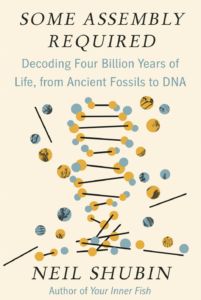Human animals are amazing on many levels. Have you recently contemplated the beauty of your hand? Have you marveled at the fact that you can open it, grab something tightly, sense temperature, gently touch your lover’s hair? And if you burn it or bruise it, it will usually heal all by itself. All of those things are so natural that it’s easy to forget how miraculous hands are. You would never be able to create a device that replicates all of these extraordinary functions.
But let’s dig a bit deeper by reading Neil Shubin’s new book,Some Assembly Required: Decoding Four Billion Years of Life, from Ancient Fossils to DNA (2020). The hand is made of cells, and there are parts to each of those cells, and the genetic code for you can be found in each of those cells. But how does that information contained in your DNA  become you? How is it possible for your genetic blueprint to build and maintain your body? Shubin’s book describes this process beautifully. I offer the following excerpt. If this kind of writing inspires you like it does me, I urge you to obtain a copy of Some Assembly Required and find a quiet place to allow your DNA powered body to read your biography. This book is about inspiring science and scientists, but it is, at bottom, about who you are.
become you? How is it possible for your genetic blueprint to build and maintain your body? Shubin’s book describes this process beautifully. I offer the following excerpt. If this kind of writing inspires you like it does me, I urge you to obtain a copy of Some Assembly Required and find a quiet place to allow your DNA powered body to read your biography. This book is about inspiring science and scientists, but it is, at bottom, about who you are.
New microscopes that allow us to see DNA molecules themselves also let us see what happens as genes turn on and off. For a gene to become active, a molecular game of Twister needs to happen. Inactive regions of the genome are tightly coiled upon themselves, bundled around other small molecules to fit inside the nucleus. These regions are closed off and so are relatively inert. Before a region of the genome can become active, it needs to uncoil and open itself up to make a protein. These are only the first steps in a finely choreographed dance that turns genes on and off. For a gene to activate, its switch needs to contact other molecules and attach to an area adjacent to the gene itself. . . .
So here are the full steps of the dance that goes on when genes turn on: the genome opens, revealing the gene and its control region, parts attach, and a protein is made. This happens in every cell, with every protein. A six-foot-long string of DNA is coiled until it is smaller than the size of the head of a pin. Conjure the image of it opening and closing in microseconds, writhing and turning to activate thousands of genes every second. From the moment of conception and throughout our adult lives, our genes are continually being switched on and off. We begin as a single cell. Over time, cells multiply, while batteries of genes are activated to control their behavior to form the tissues and organs of our bodies.
As I write this book, and as you read it, genes are switching on in all four trillion of our cells. DNA contains many supercomputers’ worth of computing power. With these instructions, a relatively small parts list of twenty thousand genes can build and maintain the complex bodies of worms, flies, and people using control regions spread across the genome. Changes to this incredibly complex and dynamic machine underlie the evolution of every creature on Earth. Always coiling, uncoiling, and folding, our DNA is like an acrobatic maestro, a conductor of development and evolution.
Shubin, Neil. Some Assembly Required (p. 73).

